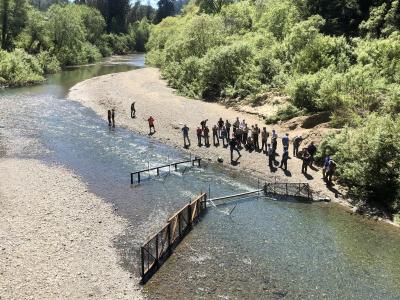Holding Space—Restoring Habitat and Making Room for Innovation
March 26 - 29, 2024
Forwarding the Fish & Fire Conversation: Where Do We Go From Here?
27 March 2024
9:00am - 5:00pm
Workshop Coordinators: Lenya Quinn-Davidson, University of California Agriculture and Natural Resources Fire Network; Josh Smith, Watershed Research and Training Center; and Will Harling, Mid Klamath Watershed Council
In recent decades, it has become increasingly clear that the West suffers simultaneously from too much fire and not enough. Fire exclusion has created vulnerable landscapes, far departed from the fire regimes through which they evolved. Losses are multifaceted: unprecedented high-severity fire is causing widespread habitat loss, while other systems wither in the absence of needed fire. Meanwhile, fire suppression activities pose a different set of threats, adding insult to injury for aquatic habitats and species. However, the two disciplines remain mostly siloed, with few opportunities to find shared value or to innovate together in management and policy efforts.
In 2023, we hosted an introductory Fire & Fish Workshop at the conference in Fortuna, focusing on the many intersections–ecological, cultural, and spatial–among fish and fire. This workshop built on that understanding, further exploring cross-disciplinary connections, identifying management implications and opportunities, and daylighting potential synergies in policy and action. This workshop included three major themes for learning and dialogue: 1) Managing the Post-Fire Landscape, delving into the McKinney Fire as an example; 2) Examples of Integrated Management and Restoration, including projects that consider and address both upland and aquatic values; and 3) Prescribed Fire 101, an interactive session where participants began to see the landscape through the lens of fire, and learn the nuts and bolts of prescribed fire planning and implementation.
Workshop Agenda:
Welcome with Robyn Meely,Graton Rancheria
Fish and Fire – The Big Picture, Gordon Reeves Ph.D, Oregon State University
Bringing Beneficial Fire Back to the Klamath Mountains, Will Harling, Mid-Klamath Watershed Council
Part 1: Managing the Post-Fire Landscape: the McKinney Fire Example
Facilitated by Josh Smith, Watershed Research and Training Center
Facilitated by Josh Smith, Watershed Research and Training Center
Lessons from the Klamath: Debris Flows, Fire Effects on Streamflow, Insights from Two Years After the McKinney Fire, Toz Soto, Karuk Tribe
Post-Fire Process-Based Restoration (PBR), Karen Pope PhD, USDA Forest Service, Pacific Southwest Research Station
Part 2: Examples of Integrated Management and Restoration
Facilitated by Will Harling, Mid-Klamath Watershed Council
Post Wildfire Observations: A Whole Lot of Gray Area, Josh Smith, Watershed Research and Training Center
Post Wildfire Observations: A Whole Lot of Gray Area, Josh Smith, Watershed Research and Training Center
Lessons from Intact Fire Regimes: Fire, Streamflow, and Biodiversity in the Illilouette Basin in Yosemite National Park, Gabrielle Boisrame, Desert Research Institute
Stream Restoration with Fire in Mind, Fire Restoration with Streams in Mind, Will Harling, Mid-Klamath Watershed Council
Part 3: Prescribed Fire 101
Led by Lenya Quinn-Davidson
This was an interactive working session that helped participants see the landscape through the lens of fire, and helped them think about what it would look like to bring prescribed fire into their management toolbox. Topics include laws and regulations, liability, burn planning, the basics of implementation, and how to connect with key partners and leaders at the local level to put fire on the ground.
Other collaborators will include: Sasha Berleman, Audubon Canyon; Ranch/Good Fire Alliance; and Sarah Gibson, The Nature Conservancy.

